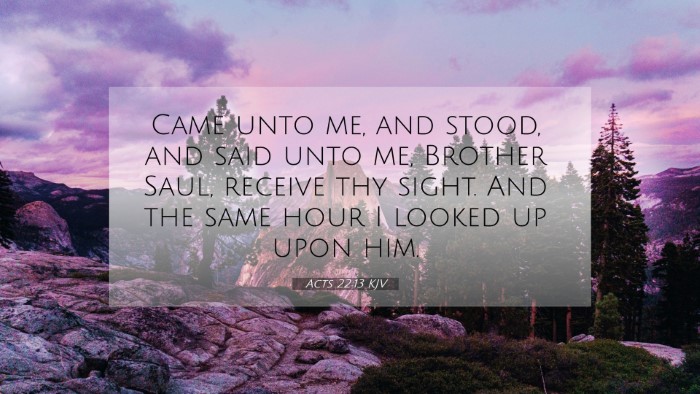Understanding Acts 22:13
Acts 22:13 states, "Came unto me, and stood, and said unto me, Brother Saul, receive thy sight. And the same hour I looked up upon him." This verse occurs during Paul’s account of his conversion experience on the road to Damascus. In this moment, Ananias provides healing and insight into Paul’s divine encounter.
Summary of the Verse Meaning
This verse highlights several critical themes that are key to understanding Paul’s transformation from a persecutor to a proponent of Christianity. The role of Ananias as a vessel of God’s mercy and guidance reflects the broader dynamics of divine intervention and the importance of obedience to God’s voice.
Thematic Connections
- Divine Encounter: Acts 22:13 illustrates the moment when Paul, previously blinded by his encounter with Christ, receives sight. This symbolizes spiritual awakening and divine revelation.
- Role of Ananias: Ananias serves as an instrument of God, showcasing the necessity of human instruments in the divine plan.
- Brotherhood in Faith: The address “Brother Saul” highlights the acceptance within the Christian community despite Paul’s past transgressions.
Cross-References and Biblical Connections
Acts 22:13 is interconnected with various Bible verses that reinforce its messages. Here are some significant cross-references:
- Acts 9:17: Ananias’ visit to Paul after his conversion highlights God’s direct command and Ananias’ obedient response.
- Acts 26:16-18: Paul recounts his commission from Jesus, emphasizing his change from persecutor to proclaimer.
- John 9:6-7: The healing of the blind man parallels Paul’s restoration of sight, illustrating the theme of spiritual and physical healing.
- 2 Corinthians 5:17: This verse speaks to the transformation believers undergo, resonating with Paul's life change.
- Isaiah 35:5: Prophecy about the blind receiving sight is fulfilled in Paul’s experience, linking Old Testament prophecy to New Testament realization.
- Matthew 10:16: This verse reflects the challenges Paul would face as a disciple, emphasizing the significance of his calling.
- 1 Timothy 1:12-16: Reflects on Paul’s gratitude for God’s mercy, connecting to his conversion as a testament to God's grace.
- Galatians 1:11-12: Paul asserts that his gospel comes from divine revelation, affirming the truth of his experience.
- Romans 8:28: Paul speaks about God working all things for the good of those who love Him, illustrating his own journey from persecution to purpose.
- Philippians 3:13-14: His desire to forget the past and strive toward the future mirrors the transformation depicted in Acts 22:13.
Insights from Commentaries
The commentaries provide a profound understanding of this moment in Paul's life:
- Matthew Henry: Emphasizes the miraculous intervention of God in Paul’s life, stressing how human beings are often the means through which divine grace operates. Ananias’ willingness to approach Paul reflects the call for Christians to reach out despite past sins.
- Albert Barnes: Notes the significance of Paul's immediate response to receive sight as indicative of his openness to change and the profoundity of his conversion experience. Barnes connects this moment to God’s grace in calling unlikely individuals to serve Him.
- Adam Clarke: Highlights the element of personal relationship, where Ananias refers to Paul as “Brother”, affirming community and inclusion in the body of Christ. Clarke also reflects on the transformational power of faith, as seen in Paul’s immediate ability to see and recognize his new identity in Christ.
Comparative Analysis
The verse serves as a focal point for comparatives between the Old and New Testaments, serving not just as historical narrative but also as spiritual guidance:
- Analyzing Isaiah prophecies alongside New Testament accounts strengthens the understanding of scripture fulfillment.
- The thematic connections between John’s account of the blind man and Paul's experience illustrate a continuity of God’s mission to bring sight to the spiritually blind.
- Paul’s transformation shares thematic parallels with other biblical figures who receive profound revelations and subsequently convey God’s message to others.
Conclusion
In conclusion, Acts 22:13 encapsulates the essence of transformation through divine intervention. It provides rich material for thematic development, cross-referencing biblical texts, and exploring God’s ongoing dialogue with humanity. For those seeking to understand the nuances of this verse, utilizing tools for Bible cross-referencing and engaging in comparative Bible verse analysis can deepen the understanding of Paul’s conversion and the significant role of community in faith.




